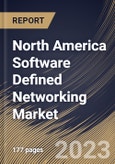SDN enhances network security by enabling a more granular and dynamic control over traffic flows. With programmable policies and centralized management, organizations can respond quickly to security threats and implement access controls. The flexibility of SDN allows for implementing security policies that can adapt to changing threat landscapes. As the transitions to 5G technology, SDN plays a pivotal role in the evolution of network architectures. SDN provides the flexibility and programmability required to support the diverse and demanding use cases of 5G, ranging from enhanced mobile broadband to massive machine-type communications and ultra-reliable low-latency communications.
Integrating SDN with edge computing is a growing trend as organizations look to deploy applications and services closer to the network's edge. This reduces latency and enhances the overall performance of edge computing solutions. SDN's ability to dynamically manage and optimize network resources aligns well with the distributed nature of edge computing. Intent-based networking is gaining traction as a natural evolution of SDN. IBN focuses on translating high-level business intent into network policies, automating configuration, and managing network infrastructure. This trend reflects a shift towards more intuitive and business-aligned network management, reducing the complexity of manual configurations.
North America, particularly the United States and Canada, boasts advanced IT infrastructure, making it conducive to adopting cutting-edge technologies like SDN. According to the National Institute of Standards and Technology, in 2021, manufacturing contributed $2.3 trillion to U.S. GDP, amounting to 12.0 % of total U.S. GDP. Including direct and indirect (i.e., purchases from other industries) value-added, manufacturing contributed an estimated 24 % of GDP. The proportions of retail e-commerce sales during the rise of the pandemic in 2020 and 2021 were 6.6% and 6.9%, respectively. Thus, the above aspects will expand the market growth across the region in the upcoming years.
The US market dominated the North America Software Defined Networking Market by Country in 2022 and would continue to be a dominant market till 2030; thereby, achieving a market value of $18,935.7 million by 2030. The Canada market is experiencing a CAGR of 19% during (2023 - 2030). Additionally, The Mexico market would exhibit a CAGR of 18% during (2023 - 2030).
Based on Offering, the market is segmented into Software, SDN Infrastructure and Services. Based on Type, the market is segmented into Open SDN, SDN via Overlay, SDN via API, and Hybrid SDN. Based on Application, the market is segmented into SD-WAN, SD-LAN, Security Applications, and Others. Based on End-User, the market is segmented into Enterprises, Telecommunication Service Providers, and Cloud Service Providers. Based on Vertical, the market is segmented into BFSI, Government & Defense, Education, Healthcare & Lifesciences, Media & Entertainment, Manufacturing, Retail & eCommerce, ITeS and Others. Based on countries, the market is segmented into U.S., Mexico, Canada, and Rest of North America.
The market research report covers the analysis of key stake holders of the market. Key companies profiled in the report include Cisco Systems Inc., Huawei Technologies Co., Ltd. (Huawei investment & Holding Co., Ltd.), VMware, Inc. (Broadcom Inc.), Dell Technologies, Inc. (Dell EMC), Juniper Networks, Inc., IBM Corporation, Ericsson AB, Ciena Corporation, Hewlett Packard enterprise Company and Nokia Corporation.
Scope of the Study
Market Segments Covered in the Report:
By Offering
- Software
- SDN Infrastructure
- Services
By Type
- Open SDN
- SDN via Overlay
- SDN via API
- Hybrid SDN
By Application
- SD-WAN
- SD-LAN
- Security Applications
- Others
By End-user
- Enterprises
- Telecommunication Service Providers
- Cloud Service Providers
By Vertical
- BFSI
- Government & Defense
- Education
- Healthcare & Lifesciences
- Media & Entertainment
- Manufacturing
- Retail & eCommerce
- ITeS
- Others
By Country
- US
- Canada
- Mexico
- Rest of North America
Key Market Players
List of Companies Profiled in the Report:
- Cisco Systems Inc.
- Huawei Technologies Co., Ltd. (Huawei investment & Holding Co., Ltd.)
- VMware, Inc. (Broadcom Inc.)
- Dell Technologies, Inc. (Dell EMC)
- Juniper Networks, Inc.
- IBM Corporation
- Ericsson AB
- Ciena Corporation
- Hewlett Packard enterprise Company
- Nokia Corporation
Unique Offerings
- Exhaustive coverage
- The highest number of Market tables and figures
- Subscription-based model available
- Guaranteed best price
- Assured post sales research support with 10% customization free
Table of Contents
Companies Mentioned
- Cisco Systems Inc.
- Huawei Technologies Co., Ltd. (Huawei investment & Holding Co., Ltd.)
- VMware, Inc. (Broadcom Inc.)
- Dell Technologies, Inc. (Dell EMC)
- Juniper Networks, Inc.
- IBM Corporation
- Ericsson AB
- Ciena Corporation
- Hewlett Packard enterprise Company
- Nokia Corporation








